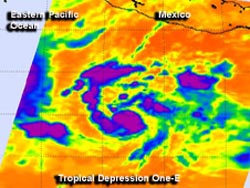NASA Sees First Eastern Pacific Tropical Depression to Open Season

NASA’s Aqua satellite flew over Tropical Depression 1-E (TD1E) at 0823 UTC (4:23 a.m. EDT) and the Atmospheric Infrared Sounder (AIRS) instrument captured an infrared image of the storm. AIRS data showed bands of thunderstorms wrapping into the low-level center from the west, as well as a fragmented band of thunderstorms east of center. Credit: NASA JPL/Ed Olsen<br>
The first tropical depression formed around 11 a.m. EDT on May 15. NASA’s Aqua satellite flew over Tropical Depression 1-E (TD1E) at 0823 UTC (4:23 a.m. EDT) and the Atmospheric Infrared Sounder (AIRS) instrument captured an infrared image of the storm.
AIRS data showed bands of thunderstorms wrapping into the low-level center from the west, as well as a fragmented band of thunderstorms east of center. Cloud top temperatures of the thunderstorms were as cold as -63 Fahrenheit (-52 Celsius) indicating strong thunderstorms with heavy rainfall potential.
At 11 a.m. EDT on May 15, TD1E had maximum sustained winds near 35 mph (55 kph). It was located far from land, about 650 miles (1,045 km) south-southwest of Acapulco, Mexico, near 9.2 north latitude and 103.6 west longitude. TD1E was moving to the west at 12 mph (19 kph) and had a minimum central pressure near 1006 millibars. There are no coastal warnings or watches in effect.
The National Hurricane Center noted that TD1E will be moving through warm waters over the next couple of days, which will likely strengthen it into Tropical Storm Alvin.
Text credit: Rob Gutro
NASA’s Goddard Space Flight Center
Media Contact
All latest news from the category: Earth Sciences
Earth Sciences (also referred to as Geosciences), which deals with basic issues surrounding our planet, plays a vital role in the area of energy and raw materials supply.
Earth Sciences comprises subjects such as geology, geography, geological informatics, paleontology, mineralogy, petrography, crystallography, geophysics, geodesy, glaciology, cartography, photogrammetry, meteorology and seismology, early-warning systems, earthquake research and polar research.
Newest articles

Recovering phosphorus from sewage sludge ash
Chemical and heat treatment of sewage sludge can recover phosphorus in a process that could help address the problem of diminishing supplies of phosphorus ores. Valuable supplies of phosphorus could…

Efficient, sustainable and cost-effective hybrid energy storage system for modern power grids
EU project HyFlow: Over three years of research, the consortium of the EU project HyFlow has successfully developed a highly efficient, sustainable, and cost-effective hybrid energy storage system (HESS) that…

After 25 years, researchers uncover genetic cause of rare neurological disease
Some families call it a trial of faith. Others just call it a curse. The progressive neurological disease known as spinocerebellar ataxia 4 (SCA4) is a rare condition, but its…





















